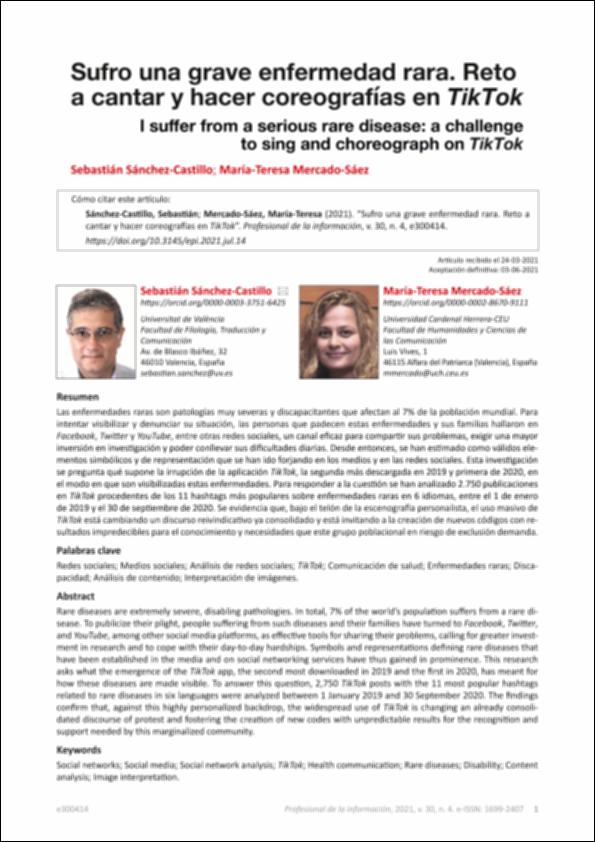Please use this identifier to cite or link to this item:
http://hdl.handle.net/10637/13704Sufro una grave enfermedad rara : reto a cantar y hacer coreografías en TikTok
| Title: | Sufro una grave enfermedad rara : reto a cantar y hacer coreografías en TikTok |
| Other Titles: | I suffer from a serious rare disease : a challenge to sing and choreograph on TikTok |
| Authors : | Sánchez Castillo, Sebastián Mercado Sáez, María Teresa. |
| Keywords: | TikTok (Social network); TikTok (Red social); Enfermdades raras.; Rare diseases.; Redes sociales en Internet.; Health education.; Análisis de contenido.; Content analysis.; Educación sanitaria.; Online social networks. |
| Publisher: | EPI |
| Citation: | Sánchez-Castillo, Sebastián y Mercado-Sáez, María-Teresa (2021). Sufro una grave enfermedad rara: reto a cantar y hacer coreografías en TikTok. Profesional de la Información, vol. 30, n. 4 (27 jul.), art. e300414. DOI: https://doi.org/10.3145/epi.2021.jul.14 |
| Abstract: | Las enfermedades raras son patologías muy severas y discapacitantes que afectan al 7% de la población mundial. Para
intentar visibilizar y denunciar su situación, las personas que padecen estas enfermedades y sus familias hallaron en
Facebook, Twitter y YouTube, entre otras redes sociales, un canal eficaz para compartir sus problemas, exigir una mayor
inversión en investigación y poder conllevar sus dificultades diarias. Desde entonces, se han estimado como válidos elementos
simbólicos y de representación que se han ido forjando en los medios y en las redes sociales. Esta investigación
se pregunta qué supone la irrupción de la aplicación TikTok, la segunda más descargada en 2019 y primera de 2020, en
el modo en que son visibilizadas estas enfermedades. Para responder a la cuestión se han analizado 2.750 publicaciones
en TikTok procedentes de los 11 hashtags más populares sobre enfermedades raras en 6 idiomas, entre el 1 de enero
de 2019 y el 30 de septiembre de 2020. Se evidencia que, bajo el telón de la escenografía personalista, el uso masivo de
TikTok está cambiando un discurso reivindicativo ya consolidado y está invitando a la creación de nuevos códigos con resultados
impredecibles para el conocimiento y necesidades que este grupo poblacional en riesgo de exclusión demanda. Rare diseases are extremely severe, disabling pathologies. In total, 7% of the world’s population suffers from a rare disease. To publicize their plight, people suffering from such diseases and their families have turned to Facebook, Twitter, and YouTube, among other social media platforms, as effective tools for sharing their problems, calling for greater investment in research and to cope with their day-to-day hardships. Symbols and representations defining rare diseases that have been established in the media and on social networking services have thus gained in prominence. This research asks what the emergence of the TikTok app, the second most downloaded in 2019 and the first in 2020, has meant for how these diseases are made visible. To answer this question, 2,750 TikTok posts with the 11 most popular hashtags related to rare diseases in six languages were analyzed between 1 January 2019 and 30 September 2020. The findings confirm that, against this highly personalized backdrop, the widespread use of TikTok is changing an already consolidated discourse of protest and fostering the creation of new codes with unpredictable results for the recognition and support needed by this marginalized community. |
| Description: | Este artículo se encuentra disponible en la siguiente URL: https://revista.profesionaldelainformacion.com/index.php/EPI/article/view/86449 Este artículo pertenece al número "Interacción y visualización ". |
| URI: | http://hdl.handle.net/10637/13704 |
| Rights : | http://creativecommons.org/licenses/by/4.0/deed.es |
| ISSN: | 1699-2407 (Electrónico) |
| metadata.dc.date.endEmbargo: | 2022-07-27 |
| Issue Date: | 27-Jul-2021 |
| Center : | Universidad Cardenal Herrera-CEU |
| Appears in Collections: | Dpto. Comunicación e Información Periodística |
Items in DSpace are protected by copyright, with all rights reserved, unless otherwise indicated.


